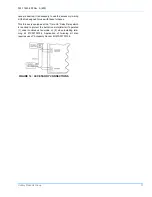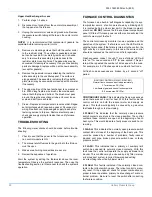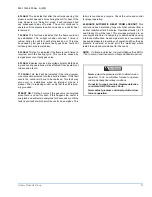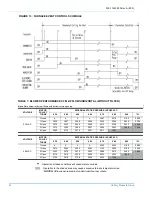
035-17443-000 Rev. A (800)
Unitary Products Group
7
VENTING
CATEGORY 1 - VERTICAL VENTING
Category 1 venting consists of vertically venting one or more
appliances in B-vent or masonry chimney (as allowed), using
single wall metal pipe or B-vent connectors. Type B vent sys-
tem extends in a general vertical direction and does not con-
tain offsets exceeding 45 degrees, except that a vent system
having not more than one 60-degree offset is permitted.
NOTE: This appliance may be common vented with another
gas appliance as allowed by the following codes and stan-
dards.
The furnace rating plate lists the maximum vent gas tempera-
ture. This temperature must be used to select appropriate
venting materials and clearances. A typical example is shown
below.
CATEGORY 1 - 450 F. MAX. VENT TEMP.
All installations must be vented in accordance with the
National Fuel Gas Code, NFPA 54 / ANSI Z223.1 - latest edi-
tion. For reference, the National Fuel Gas Code Handbook,
available from NFPA (item JP-54HB96) is recommended.
The appliance must also be vented in compliance with all
local utility and code requirements. In Canada, the furnace
must be vented in accordance with the National Standard of
Canada, CAN / CGA-B149.1 and.2 - latest editions.
HORIZONTAL SIDEWALL VENTING
For applications where vertical venting is not possible, the
only approved method of horizontal venting is through the
use of an auxiliary power venter. Approved power venters are
Fields Controls Model SWG-4Y or Tjernlund Model GPAK-JT.
Follow all application and installation details provided by the
manufacturer of the power venter.
VENT SAFETY CHECK PROCEDURE
The following steps shall be followed with each appliance
connected to the venting system placed in operation, while
any other appliances connected to the common venting sys-
tem are not in operation.
1.
Seal any unused openings in the common venting sys-
tem.
2.
Inspect venting system for proper size and horizontal
pitch, as required in the National Fuel Gas Code ANSI
Z223.1 or the CAN / CGA B149 Installation Codes and
these instructions. Determine that there is no blockage
or restriction, leakage, corrosion or other deficiencies
which could cause an unsafe condition.
3.
Insofar as is practical, close all building doors and win-
dows and all doors between the space in which the appli-
ance(s) connected to the venting system are located and
other spaces of the building. Turn on clothes dryers and
any other appliances not connected to the common vent-
ing system.
Turn on any exhaust fans, such as range hoods and
bathroom exhausts so they will operate at maximum
speed. Do not operate a summer exhaust fan. Close fire-
place dampers.
4.
Follow the lighting instructions. Place the appliance
being operated in operation. Adjust thermostat so appli-
ance will operate continuously at full input rate.
5.
Test for draft hood equipped appliance spillage at the
draft hood relief opening after 5 minutes of main burner
operation. Use the flame of a match or candle.
6.
After it has been determined that each appliance con-
nected to the venting system properly vents when tested
as outlined above, return doors, windows, exhaust fans,
fireplace dampers and any other gas-burning appliance
to its previous condition of use.
7.
If improper venting is observed during any of the above
tests, the venting system must be corrected.
8.
Any corrections or resizing of the common venting sys-
tem must be in accordance with the National Fuel Gas
Code, ANSI Z223.1 or Section 7, Venting Systems and
Air Supply for Appliances, CAN/CGA B149.1 or.2 Instal-
lation Code - latest editions. If the common vent system
must be resized, it should be resized to approach the
minimum size as determined using the appropriate
tables in Appendix G of the above codes.
It is the responsibility of the installer to verify
proper vent system operation.
A furnace shall not be connected to a chimney flue
serving a separate appliance designed to burn
solid fuel.
This furnace requires the use of a special 4" to 5"
vent adapter. It is provided with the furnace and
must be installed.
If this furnace is replacing a common-vented fur-
nace, it may be necessary to resize the existing
vent line and chimney to prevent oversizing prob-
lems for the new combination of units. Refer to the
National Fuel Gas Code, ANSI Z223.1 or CAN/
CGA B149.1 or .2 Installation Code - latest edi-
tions.








































